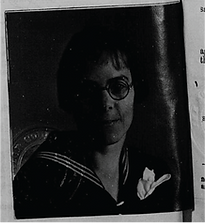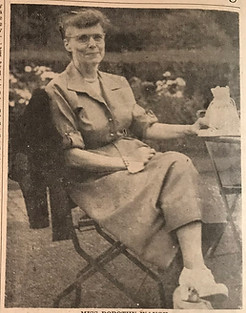about
dorothy waugh













HER LIFE
1896-1996
Dorothy Waugh was an individual who excelled at many things, and most of her passions found their way into her professional life at one time or another.
Born in Burlington, Vermont, Dorothy grew up in Amherst, Massachusetts, from age six, where her love of the natural world was fostered from an early age.1 Her father, a world-renowned horticulturist, headed the Division of Horticulture as well as the Department of Landscape Architecture at the Massachusetts Agriculture College (MAC, later known as the Massachusetts State College, and now the University of Massachusetts), an institution known the world over for their program and department.2 Dorothy was well-educated and came from a family of intellectuals and creatives.3 She graduated with honors from the Art Institute of Chicago in 1928. However, she also studied at other institutions, including Landscape Architecture at the University of Massachusetts, the Massachusetts School of Art (Boston), and the Museum School of the Cleveland Museum of Art, among others.4 After graduation from the Art Institute of Chicago, she worked for a commercial art studio for several years before moving to New York City. 5,6
Dorothy Waugh began her time with the National Park Service (NPS) in 1933. While her work did not begin with designing posters for the NPS during the WPA years, they are, perhaps, the work she is best known for. These posters extolled the merits of the parks, from types of recreation to encouraging conservation efforts to simply reminding Americans of the many parks, both state and national, that existed throughout the country. Beyond the 17 posters she designed for the National Park Service (examples of 12 remain), she also worked on several other important projects for the Department of the Interior (DOI) and the then newly-established State Parks Division. 7,8,9
Dorothy was a capable illustrator and draftsperson and was considered a landscape architect in her own right, working as a landscape architect in various places around the country, including Boston and New Orleans.10,11,12 Before she began designing posters for the NPS, Dorothy worked on several portfolios for the State Parks Division, where she was hired by Conrad Wirth, who had been taught and mentored by Frank Waugh, her father, at MAC.13 Her work on the Portfolio of Comfort Stations and Privies and the Portfolio of Park Structures included designs that could be distributed and used to build actual structures in parks throughout the country by the WPA’s Civilian Conservation Corps (CCC).14 She designed a series of stamp-size stickers reminiscent of her NPS poster designs to be used as another means to advertise the parks.15,16 These could be used on maps to indicate their locations throughout the country, among other applications. (National Park Service.17 Dorothy was also commissioned to create the infographics and illustrations for a substantial and important report for the Department of the Interior and NPS regarding natural resources and park usage throughout the country.18
You may think this seems like quite a robust resume already, but Dorothy was seemingly never idle. In 1937, Dorothy was hired as the head of the Children’s Book Division for the Alfred P. Knopf Publishing Company, a role she held for the next three years.19 She lived in New York City at the time. However, she also handled all the public relations, marketing, and print design work for the Montclair Public Library in New Jersey, where she maintained her role as, Director of Public Relations until 1965.20 She was also a public relations consultant with the Montclair mayoral office during this time.21,22 Examples of her work for the Montclair Public Library are held in the Jones Library’s special collections.
Dorothy was a natural educator, and many of the articles and books she wrote and or illustrated spoke to this. She taught at Parsons School of Design and the Cooper Union School of Art, which continue to be respected art and design schools.23,24,25 She was passionate about books and book design, writing many articles regarding best practices and unpacking how successful layout design was achieved.26,27,28 She contributed layout designs for the books she published as head of the Children’s Book Division at Alfred P. Knopf Publishing Company and for many of the other publications she worked on. This also included the articles that she contributed to national journals and magazines. Beyond layout design and writing, Dorothy contributed poems and illustrations to numerous publications over the course of her career.
Some of the publications that she contributed to include: A-D Magazine, The Horn Book, Horticulture, American Artist, Family Circle, Parents Magazine, Christian Science Monitor, American Mercury, Popular Gardening, and Print (a quarterly journal for the Graphic Arts), among many others.29,30
Her deep love of and interest in nature went beyond her formative years and her time in the WPA and NPS. She also wrote about the natural world, covering such topics as floral, landscape, and garden design on many occasions. This also included her own books that she both wrote and illustrated, Warm Earth and Among the Leaves and Grasses, as well as books by other authors that she contributed her artistic skill through illustrations, What’s in the Sky, Garden Design for Beginners, and Innocent Summer.
Dorothy also published two scholarly books during her life about Emily Dickinson--Emily Dickinson’s Beloved, A Surmise, and Emily Dickinson Briefly--another Amherst daughter and renowned poet whom Dorothy had long-admired. She also mounted an exhibition about Emily Dickinson at the Jones Library in Amherst which included many original drawings and paintings of Dickinson’s home and gardens.31 Perhaps out of her love for Dickinson, she wrote poetry of her own. Her poems were published in multiple magazines, and she also completed a book of poems that was never officially published.32,33,34 She was also working on a book, Early History of Connecticut River Valley, that was incomplete at the time of her death and, thus, never published.35
It is clear that Dorothy loved the design surrounding holidays and adornment. This was evidenced in the publication of two of her books that were entirely dedicated to design and decorations for holidays, Festive Decorations the Year Round and A Handbook of Christmas Decorations. These were both well-received. In addition to writing these books, she contributed all the illustrations and constructed all the projects she detailed.
For seven years, she presented a radio program of interviews and commentary on WVNJ. Additionally, throughout her career, she was part of numerous radio and TV programs on other stations.36
In terms of her personal life, Dorothy appeared happy, content, and fulfilled. She was close with her family, her parents, and siblings, and her correspondence held in the Jones Library archives and book dedications indicate as much.37,38 However, she herself never married. One must wonder if this was more out of necessity than a personal desire to remain single, as married women traditionally did not work outside the home.39
Her work reflected the woman, and that seemed to have been enough for Dorothy. She lived a long (99 years) and extremely productive life, contributing to the field of design in many ways over the course of her career. Dorothy proves that you don’t have to specialize in one specific area to be considered both proficient and even, in some cases, an expert. Drawing on her many passions, she forged a life that was both meaningful and robust in its accomplishments.
her work
The easiest place to begin is with Dorothy's time with the WPA. Technically, Dorothy was working for
the National Parks Service at various locations throughout the country rather than in a specific state's poster division. She created a variety of materials during her time there, not simply posters.





